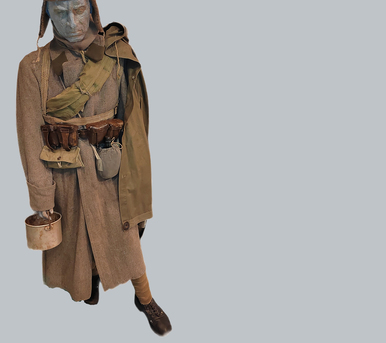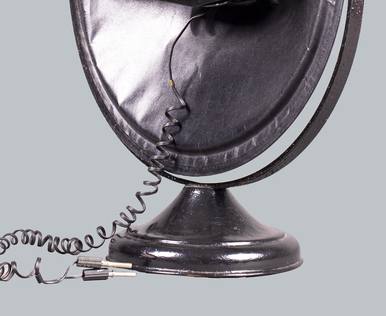This mannequin is dressed in the uniform of a Red Army soldier of the Great Patriotic War era. A bekesha is a single-breasted winter coat with pleats at the waist on the back, trimmed with fur along the collar, sleeves, pockets and hem.
Such coats were made of tanned sheepskin. A bekesha was fastened with external loops and large light buttons, rather than with hooks. In the lower part, such a coat had a long skirt and two vertical slash pockets.
The turndown collar of the coat was made of white sheepskin. The word bekesha comes from the surname of the Hungarian commander Gáspár Bekes, who wore such clothes in the 16th century. It came to Russia in the second half of the 18th century.
Often a bekesha was called a half-length fur coat or a sheepskin coat; in time these terms began to be used to refer to the exact same clothing item. At the same time, the invariable characteristic detail of a bekesha was the fur edge and the bottom half in the shape of a skirt. All other elements were changeable. In the Red Army, a bekesha as a type of coat of a Red Army soldier was introduced by order of the Revolutionary Military Council of the USSR No. 20 from December 23, 1931.
In addition to the bekesha, the mannequin wears an exact replica of valenki that the Red Army soldiers wore during the Great Patriotic War. These were warm felt boots of gray color made of sheep wool. The boot-top was wider, and the toe was round.
Industrial production of such shoes was established in the Russian Empire in the 18th century, mainly in Siberia and in the northern regions. For the first time at the front, valenki began to be used during the Soviet-Finnish War of 1939–1940.
A semi-automatic TT pistol (Tula Tokarev) of the 1933 model is kept in the holster. In 1930, it was developed by a group led by Fyodor Vasilievich Tokarev in the design bureau of the Tula Arms Plant. The pistol was distinguished by high penetration power, a long effective firing range, and high accuracy.
The main advantages of the TT were its small weight and dimensions, as well as the absence of protruding parts. The placement of the trigger mechanism in a separate unit made it easier to care for the weapon and eliminated the possibility of losing small parts. In 1932–1933, a new model with some alterations was designed in order to simplify the manufacturing process. Tokarev’s pistols were first used in the Battles of Khalkhin Gol and Lake Khasan.


